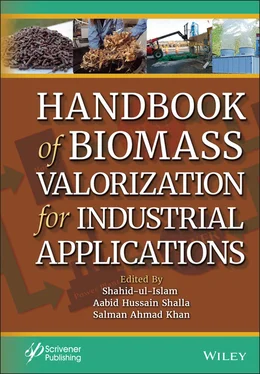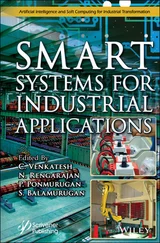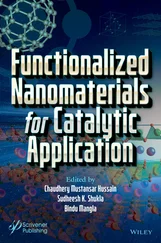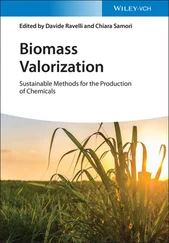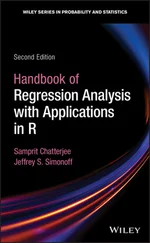Handbook of Biomass Valorization for Industrial Applications
Здесь есть возможность читать онлайн «Handbook of Biomass Valorization for Industrial Applications» — ознакомительный отрывок электронной книги совершенно бесплатно, а после прочтения отрывка купить полную версию. В некоторых случаях можно слушать аудио, скачать через торрент в формате fb2 и присутствует краткое содержание. Жанр: unrecognised, на английском языке. Описание произведения, (предисловие) а так же отзывы посетителей доступны на портале библиотеки ЛибКат.
- Название:Handbook of Biomass Valorization for Industrial Applications
- Автор:
- Жанр:
- Год:неизвестен
- ISBN:нет данных
- Рейтинг книги:4 / 5. Голосов: 1
-
Избранное:Добавить в избранное
- Отзывы:
-
Ваша оценка:
- 80
- 1
- 2
- 3
- 4
- 5
Handbook of Biomass Valorization for Industrial Applications: краткое содержание, описание и аннотация
Предлагаем к чтению аннотацию, описание, краткое содержание или предисловие (зависит от того, что написал сам автор книги «Handbook of Biomass Valorization for Industrial Applications»). Если вы не нашли необходимую информацию о книге — напишите в комментариях, мы постараемся отыскать её.
BIOMASS VALORIZATION
INDUSTRIAL APPLICATIONS
The handbook provides a comprehensive view of cutting-edge research on biomass valorization, from advanced fabrication methodologies through useful derived materials, to current and potential application sectors.
Audience Handbook of Biomass Valorization for Industrial Applications
Handbook of Biomass Valorization for Industrial Applications — читать онлайн ознакомительный отрывок
Ниже представлен текст книги, разбитый по страницам. Система сохранения места последней прочитанной страницы, позволяет с удобством читать онлайн бесплатно книгу «Handbook of Biomass Valorization for Industrial Applications», без необходимости каждый раз заново искать на чём Вы остановились. Поставьте закладку, и сможете в любой момент перейти на страницу, на которой закончили чтение.
Интервал:
Закладка:
In the ATR process, SR and POR occur simultaneously in the same reactor. The reaction mixture contains glycerol vapors, steam, and oxygen. ATR has been identified as a promising process because of its energy self-sufficiency. This feature of ATR attributes to the endothermic nature of SR and the exothermic behavior of POR reactions. Oxygen delivers the required heat via the oxidation reactions, which is the major reason for ATR to be energy efficient. This reaction does not need an external power supply, which reduces the operating cost. ATR is different from POR because of the supply of water vapor, which increases hydrogen production. Another advantage of ATR is that small volume units are possible to fabricate for decentralized small-scale production due to the high efficiency and compactness of the reaction system. The optimized reaction condition for hydrogen production was reported at T = 600–750 °C, steam/glycerol molar ratios 9/1–12/1, and oxygen in proportion 0–0.4 [9, 13]. Some major side reactions, for example, methanation and coke deposition can also be reduced significantly under this condition.
APR is a process of transforming glycerol in the aqueous medium without pre-vaporization. APR is usually conducted at moderate temperature (~250 °C) and high pressure (60 atm) in a continuous fixed-bed reactor. The overall reaction of APR is expressed in Equation (4.1). First, glycerol is decomposed into syngas ( Equation (4.2)), and then syngas converts into CO 2and H 2through a water-gas shift reaction ( Equation (4.3)). The generated H 2is utilized by reacting with intermediates such as CO and hydroxides and in dehydration reactions. This process takes into account the scission of the C–C, C–H, and C–O bonds [41]. To achieve significant selectivity for H 2production, the catalyst must break the C–C bond and expedite the reaction of CO with water vapor on its active sites. However, it should not favor the scission of the C–O bond or dehydration reaction, which is responsible for the formation of alkanes.
APR exhibits several advantages in comparison to the steam reforming method, e.g., (a) low reaction temperature; (b) greater energy efficiency because of the liquid/liquid phase; (c) lower cost of reactor system because of the liquid system; and (d) lower energy cost because of no need of the steam-generating system. The main advantage of this process is that it is a liquid-phase process, unlike other existing technologies which occur in the gas phase. It is also important for other biomass-derived liquids which vaporize at high temperature. The main disadvantages of this process in comparison to SR are its low selectivity towards H 2because of low operating temperature, and the high tendency of the formation of alkanes.
Rahman et al . [43] have used multiwalled carbon nanotubes supported by bimetallic Pt–Ni and Cu–Ni composites for the APR of glycerol in a continuous fixed-bed reactor. Multiwalled carbon nanotubes were selected as support because of mesoporous structure, low mass transfer resistance, high surface area, and high thermal stability. The catalyst with 1 wt% Pt and 3 wt% Ni exhibited the best performance with glycerol conversion >99%, selectivity for hydrogen = 90%, and rate of formation = 21.2 mmol H 2g cat –1h –1at T = 250 °C and P = 40 bar. The catalyst showed higher activity and selectivity for the production of hydrogen as compared to the monometallic catalyst. This catalyst retains its activity up to 100 h test cycle and thus, suitable for long-term operations [43]. The incorporation of Re over Pt/C increases the turnover frequency for the formation of synthesis gas from glycerol [44]. Table 4.3summarizes the performance of different catalysts for reforming.
Dumesic and co-workers reported several studies for the APR of glycerol using carbon-based materials as supports [44, 45]. Carbon-supported platinum–rhenium catalysts (Pt–Re/C) have been employed for the transformation of glycerol into hydrogen or synthesis gas. It was observed that a Pt–Re/C catalyst with an atomic ratio Pt/Re =1 showed high catalytic activity, selectivity to syngas, and long-term stability [45]. The carbon was used as support owing to its long-term hydrothermal stability [44].
The pyrolysis of glycerol with the support of carbonaceous catalyst is an important method for the formation of syngas with a higher H 2/CO ratio. Other methods used for the formation of synthesis gas include dry and steam reforming of glycerol. Fernandez et al . [46] have compared the above three methods (steam reforming, dry reforming, and pyrolysis) for the synthesis of syngas using commercially available activated carbon as a catalyst. Carbon-base catalyst was favorable for generating syngas with H 2/CO ratio not far from 1, reduce the CO 2fraction in the gaseous product. The reforming of glycerol uses CO 2(dry reforming) or H 2O (steam reforming) as an oxidizing agent which encourages the higher conversion of glycerol as compared to pyrolysis. The dry reforming generates the lowest amount of hydrogen and syngas, and the highest amounts gas fraction, whereas the reverse occurs in the steam reforming process. They have also compared the microwave-assisted process with the conventional heating process. The microwave-assisted method promotes more conversion of glycerol as compared to the conventional method [46].
4.4.2.4 Oxidation of Glycerol
Due to its highly functionalized nature, glycerol is also used as a feedstock for the synthesis of useful oxygenates. Several oxygenated compounds such as mesooxalic acid, glyceric acid, dihydroxyacetone, oxalic acid, tartronic acid, hydroxyethanoic acid, etc., can be produced from the complex reaction pathway through oxidation of glycerol. These compounds, especially mesooxalic acid and tartronic acid, are important chelating agents, which have the potential for the production of valuable polymers and chemicals. Dihydroxyacetone can be used as a building block in organic synthesis and as a basic repeating unit of new degradable polymers [12, 13]. To date, these chemicals have inadequate utilization because they are either synthesized using expensive and environmentally harmful oxidation processes (e.g. K 2Cr 2O 7, HNO 3, H 2CrO 4) or less productive fermentation process The possible reaction pathways to oxygenated derivatives of glycerol is shown in Scheme 4.5.
The heterogeneous catalytic oxidation process can be used for the oxidation of a unique structure of glycerol using low-cost oxidizing agents such as oxygen, air, and H 2O 2instead of environmentally harmful oxidants, e.g., K 2Cr 2O 7, HNO 3, H 2CrO 4, etc. The synthesis of a highly selective catalyst is the main challenge in this oxidation reaction. This catalyst must be selective towards either the oxidation of the primary alcohol group, to produce glyceric acid, or the oxidation of the secondary alcohol group, to synthesized hydroxypyruvic acid and dihydroxyacetone. Several studies have been reported for chemoselective glycerol oxidation over supported noble metal nanoparticles such as Pt, Pd, and Au. In general, the selective oxidation of glycerol takes place in the aqueous medium. Table 4.3summarizes the performance of different catalysts.
The Au particles supported on multiwalled carbon nanotubes enhance the chemoselectivity for glycerol oxidation towards the formation of dihydroxyacetone. The catalyst shows 60% selectivity along with the high activity. The results were compared by using activated carbon under similar metal loading and particle size. The activated carbon encourages the synthesis of glyceric acid. The study suggests that the type of supports play significant role in chemoselectivity [47]. Selective oxidation of crude glycerol into lactic acid and glyceric acid has been carried by different groups using carbon as a support for Pt, Pd, Cu–Pt and Au–Pd etc. [48–50].
Читать дальшеИнтервал:
Закладка:
Похожие книги на «Handbook of Biomass Valorization for Industrial Applications»
Представляем Вашему вниманию похожие книги на «Handbook of Biomass Valorization for Industrial Applications» списком для выбора. Мы отобрали схожую по названию и смыслу литературу в надежде предоставить читателям больше вариантов отыскать новые, интересные, ещё непрочитанные произведения.
Обсуждение, отзывы о книге «Handbook of Biomass Valorization for Industrial Applications» и просто собственные мнения читателей. Оставьте ваши комментарии, напишите, что Вы думаете о произведении, его смысле или главных героях. Укажите что конкретно понравилось, а что нет, и почему Вы так считаете.
